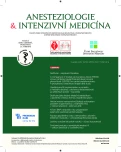Papillary muscle rupture in patient with acute myocardial infarction – echocardiographic case report
Authors:
Rulíšek Jan 1; Rohn Vilém 2; Kovárník Tomáš 3; Dobiáš Miloš 1; Balík Martin 1
Authors‘ workplace:
n1Klinika anesteziologie resuscitace a intenzivní medicíny, Všeobecná fakultní nemocnice a 1. LF UK, Praha
; Klinika kardiovaskulární chirurgie, Všeobecná fakultní nemocnice a 1. LF UK Praha
2; 2. interní klinika, Všeobecná fakultní nemocnice a 1. LFUK, Praha
3
Published in:
Anest. intenziv. Med., 24, 2013, č. 3, s. 179-182
Category:
Anaesthesiology - Case Report
Overview
Acute papillary muscle rupture is one of the mechanical complications of acute myocardial infarction. If treated conservatively, mortality exceeds 90%. Rapid diagnosis and indication of a surgical procedure can dramatically improve the patients’ prognosis. During the diagnostic process, transoesophageal echocardiography plays a major role as it reveals the mechanism of mitral valve regurgitation. We present a case report of a 66 year old man with papillary muscle rupture, where fast diagnosis and surgical treatment resulted in successful management of the disease.
Keywords:
papillary muscle rupture – transoesophageal echocardiography – acute myocardial infarction
Sources
1. Zvolský, M. Nemocnost a úmrtnost na ischemické nemoci srdeční v ČR v letech 2003–2010. ÚZIS ČR. Dostupné na: www.uzis.cz.
2. Fox, K. A. A. et al. Decline in rates of death and heart failure in acute coronary syndromes, 1999–2006. JAMA, 2007, 297, p. 1892–1900.
3. Yeh, R. W., Sidney, S., Chandra, M. et al. Population trends in the incidence and outcomes of acute myocardial infarctionN. Engl. J. Med., 2010, 362, p. 2155–2165.
4. Mandelzweig, L., Battler, A., Boyko, V. et al. The secondeuro heart survey on acute coronary syndromes: characteristics, treatment, and outcome of patients with ACS in Europe and the Mediterranean Basin in 2004. Eur. Heart J., 2006, 27, p. 2285–2293.
5. Tanimoto, T., Imanishi, T., Akasaka, T. et al. Prevalence and clinical significance of papillary muscle infarction detected by late gadolinium-enhanced magnetic resonance imaging in pa-tients with ST-segment elevation myocardial infarction. Circulation, 2010, 122, p. 2281–2287.
6. Patrick, T. et al. 2013 ACCF/AHA Guideline for the management of ST-elevation myocardial infarction. Circulation, 2013, 127, p. e362–e425.
7. Widimský, P. et al. Diagnostika a léčba akutního infarktu myokardu s ST elevacemi. Cor. et vasa, 2009, 51, 10, p. 724–740.
8. Schroeter, T. et al. Clinical outcome after mitral valve surgery due to ischemic papillary muscle rupture. Ann. Thorac. Surg., 2012, 4, p. S0003–49.
9. Yosefy, C. et al. Mitral regurgiattion after anteroapical myocardial infarction new mechanistic insights. Circulation, 2011, 123, p. 1529–1536.
10. Zoghby et al. Recomendation s for evaluation of the severity of native valvular regurgutation with two dimensional and dop-pler echocardiography. J. Am Soc. of Echocardiography, 2003, p. 777–801.
Labels
Anaesthesiology, Resuscitation and Inten Intensive Care MedicineArticle was published in
Anaesthesiology and Intensive Care Medicine

2013 Issue 3
Most read in this issue
- N-Terminal-Pro Brain Natriuretic Peptide (NT-pro BNP) and Troponin I as prognostic markers of septic cardiomyopathy
- Current practice in obstetric anaesthesia. Part II General anaesthesia for Caesarean Section
- Papillary muscle rupture in patient with acute myocardial infarction – echocardiographic case report
-
Kidney and composition of infusion solutions.
Reason for caution
